 In February 1913 the facings of the Notts and Derby Regiment changed from “White” to “Lincoln Green” following War Office authority.
In February 1913 the facings of the Notts and Derby Regiment changed from “White” to “Lincoln Green” following War Office authority.
Captain Francis Robinson attended a machine gun course at Chelsea in line with his duties as Machine Gun Officer. Lieutenant Herbert Brooke-Taylor attend a musketry course at Manchester, whilst Captain Edgar Heathcote and 425 Sergeant John Atherton attended a refresher course at the Hythe Army School for Musketry in Kent.
On June 21st the Battalion, under the Command of Colonel Clayton, paraded in Review Order in Chesterfield.
On 27th July the Battalion proceeded to Clumber Park for annual training until August 10th. Seven hundred and thirty nine Officers and men attended the Camp for 15 days, and 153 for less than 15 days.
 Following a serious fire in March 1879, Henry Pelham-Clinton (1864 – 1928), the 7th Duke of Newcastle-under-Lyme, had Clumber House magnificently rebuilt to designs by the Architect Charles Barry, Jr.
Following a serious fire in March 1879, Henry Pelham-Clinton (1864 – 1928), the 7th Duke of Newcastle-under-Lyme, had Clumber House magnificently rebuilt to designs by the Architect Charles Barry, Jr.
This was a Sherwood Foresters Brigade Camp and the other Battalion of the Brigade were based at Sparken Hill near to Worksop (5th Battalion), Welbeck Park (7th Battalion) and Thornby Park (8th Battalion) respectively. At this time Clumber Park was part of the Estate of the Duke of Newcastle and it is recorded in the Regimental Annual that swimming in lake was very popular due to the dry hot summer of that year.
 “Clumber” (by H.P. Hansen #601)
“Clumber” (by H.P. Hansen #601)
Tunic Order Parade at Clumber Camp. Amongst the Officers are William Broomhead, Victor Robinson and Joseph Tolsom suggesting that this might show men of both “A” and “B” Companies.
Medals being awarded by the Duke and Duchess of Newcastle
Work during this camp was primarily devoted to Company training, with the inclusion of several inter-battalion exercises.
On Friday 1st August the Brigade concentrated at Budby and bivouacked in a field adjoining the village. Letters C, E, G and H Companies, under the Command of Major Goodman, manned outposts to the south in Budbuy Forest. This defensive line was difficult to watch owing to the extensive number of trees. On the following day the Battalion moved south of the railway and with the 5th and 7th Battalions, under the command of Lieut.-Colonel Birkin, attacked a position occupied by the 8th Battalion. This manoeuvre was the first for the new webbing equipment that had been issued to the men shortly before Camp. It was felt by many that this new equipment was a great improvement over the leather bandoliers that had been issued to the men in 1910.
During the Camp the men were also able to enjoy various recreational events, which included amongst other activities, a Cricket match between the Battalion and the Clumber Cricket Club. This resulted in a win for the Battalion due in no little part to the batting and bowling of Captain Herbert Brooke-Taylor.
Letter “A” (Chesterfield) Company
“A” (Chesterfield) Company at Camp in Clumber Park. Colonel Clayton (centre) is flanked on his left by Lieutenants Victor Robinson and William Broomhead on his right by Captain Arthur Hopkins on his right. Also present are Sergeants JH Platts, W Bramwell and R Holmes.

 “Inspection by the Duke of Newcastle” (H.P. Hansen #641 and #644)
“Inspection by the Duke of Newcastle” (H.P. Hansen #641 and #644)
The Battalion have formed Quarter-Column as the Duke inspects the men accompanied by Colonel Clayton. 280 Colour-Sergeant John Henry Platts is standing at the rear of the formation suggesting that this may be “A” Company. After the Parade the Duke and Duchess were entertained to Lunch by the Officers of the Battalion. In the evening half of the Officers dined at Clumber House, the remainder experiencing the same hospitality the following evening.
Letter “B” (Chapel-en-le-Frith & Hope Valley) Company
 This post card was sent by ‘Wilfred’ to Nurse Carrington at High Peak Hospital in Chapel-en-le-Frith on 7th August 1913 (H.P. Hansen #625).
This post card was sent by ‘Wilfred’ to Nurse Carrington at High Peak Hospital in Chapel-en-le-Frith on 7th August 1913 (H.P. Hansen #625).
 Jemmina Carrington was born in 1874 the daughter of James Carrington, a farmer at “Knowl Top”, Brierley Green near Chinley. By 1911 she was working as a nurse in High Peak Isolation Hospital, which was located at Chinley and served the local hamlets of Bugsworth and Chinley. Research by myself suggests that ‘Wilfred’ is Wilfred Bernard Longson, since the Longson and Carrington families were related through their grandparents. 1464 Wilfrid Longson was born in 1894 and attended the local Wesleyan School with his brother Cuthbert, who was born in 1896. Wilfred enlisted into “B” Company, the 6th Notts and Derby Regiment in June 1911 and at that time he was a shop assistant in Chapel-en-le-Frith. Cuthbert enlisted a year later in August 1912 and was a moulder by trade. Wilfrid and Bertie arrived in France with the 6th Battalion on 28th February 1915. Bertie was wounded by a shell explosion at Ypres on the 4th July and had both legs amputated. He was discharged from the Army on the 26th June 1916. Wilfrid was also wounded and returned to England in July 1915 before returning to France. He was mentioned in despatches in June 1916 and won the Military Medal “for gallantry and devotion to duty” on the 1st July 1916. He was later granted a Commissioned in the 6th Notts and Derby Regiment in August 1917. After the War Wilfrid returned to live at Burrfields House in Chapel-en-le-Frith. Wilfrid’s and Berties younger brother Matthew also served with the colours. In addition their cousin Frank also enlisted in the 6th Battalion in September 1914. He won the D.C.M. in 1917 for “conspicuous gallantry in action and devotion to duty. He organised and led a squad of bombers against the enemy with the greatest skill and determination. Following up the retreating enemy, he inflicted severe casualties with machine gun and rifle fire” and was later granted a Commission in January 1918.
Jemmina Carrington was born in 1874 the daughter of James Carrington, a farmer at “Knowl Top”, Brierley Green near Chinley. By 1911 she was working as a nurse in High Peak Isolation Hospital, which was located at Chinley and served the local hamlets of Bugsworth and Chinley. Research by myself suggests that ‘Wilfred’ is Wilfred Bernard Longson, since the Longson and Carrington families were related through their grandparents. 1464 Wilfrid Longson was born in 1894 and attended the local Wesleyan School with his brother Cuthbert, who was born in 1896. Wilfred enlisted into “B” Company, the 6th Notts and Derby Regiment in June 1911 and at that time he was a shop assistant in Chapel-en-le-Frith. Cuthbert enlisted a year later in August 1912 and was a moulder by trade. Wilfrid and Bertie arrived in France with the 6th Battalion on 28th February 1915. Bertie was wounded by a shell explosion at Ypres on the 4th July and had both legs amputated. He was discharged from the Army on the 26th June 1916. Wilfrid was also wounded and returned to England in July 1915 before returning to France. He was mentioned in despatches in June 1916 and won the Military Medal “for gallantry and devotion to duty” on the 1st July 1916. He was later granted a Commissioned in the 6th Notts and Derby Regiment in August 1917. After the War Wilfrid returned to live at Burrfields House in Chapel-en-le-Frith. Wilfrid’s and Berties younger brother Matthew also served with the colours. In addition their cousin Frank also enlisted in the 6th Battalion in September 1914. He won the D.C.M. in 1917 for “conspicuous gallantry in action and devotion to duty. He organised and led a squad of bombers against the enemy with the greatest skill and determination. Following up the retreating enemy, he inflicted severe casualties with machine gun and rifle fire” and was later granted a Commission in January 1918.
Medal index cards for (1464/240128) Wilfred, (1721) Bertie and (2305/240518) Frank Longson showing their arrival in France on the 28th February 1915.
Letter “C” (Ashbourne and Buxton) Company
 “C Coy Clumber 1913” (unknown publisher #637).
“C Coy Clumber 1913” (unknown publisher #637).
The Officer seated on the left is Lt. Cyril Benton Johnson. The Officers and men are in Tunic Order and many wear the Imperial Service Badge. At this time Captain Edgar Horace Heathcote was officer Commanding “C” Company. Colour Sergeant Brindley is seated to the righto of the Officers.
In the front row is a bugler from the Battalion band who is wearing dress uniform and an Imperial Service Badge.
 “Duke II. The Ram of The 6th Ts Notts & Derbys” (A. Health, Clay Cross).
“Duke II. The Ram of The 6th Ts Notts & Derbys” (A. Health, Clay Cross).
These two cards belonged to the Drabble family of Church Street in Ashbourne. The postcard of Duke II was sent to May Drabble by her brother Harry who was serving with “C” Company of the 6th Battalion. May was 17 years old and Harry was 16 years old at time and their father was a Grocer and Wine and Spirit merchant in Ashbourne. Harry later re-enlisted into the 6th Battalion in November 1914 and proceed overseas in 1916. He was later granted a Commission in June 1917. Interestingly, this photograph of Duke II was originally taken in 1910 but the date has been erased for this version, which was then sold by Albert Heath of Thanet Street in Clay Cross.
Letter “D” (Bakewell, Tideswell and Stoney Middleton) Company
content to follow
Letter “E” (Wirksworth and Matlock) Company
content to follow
Letter “F” (Staveley and District) Company
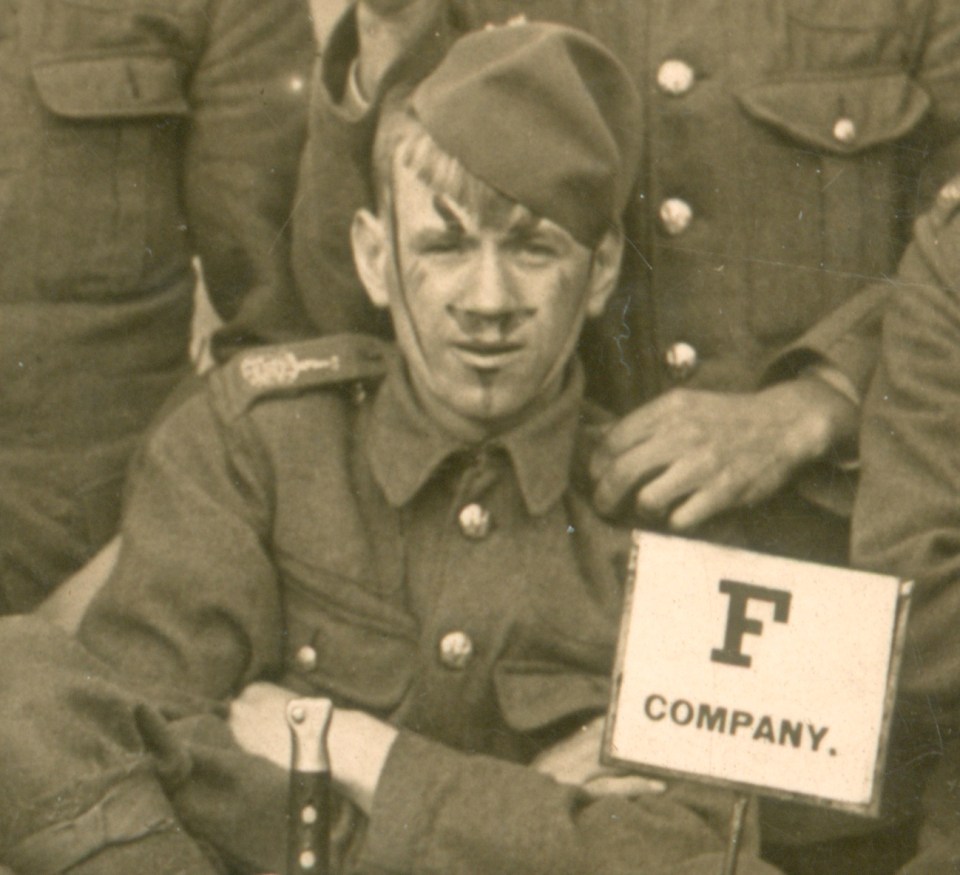
Letter “G” (Clay Cross) Company
 “At the Camp Concert” (Morley’s Series).
“At the Camp Concert” (Morley’s Series).
This humorous post card was sent by 623 Corporal Frederick Montgomery of “G” (Clay Cross) Company to his sweetheart “Annie”.
Frederick was born in 1891 and lived with his mother and stepfather at Stollard Street in Clay Cross. He worked for the Clay Cross Company and was a metal pipe cutter by trade. Fred was enlisted into the 6th Battalion Notts & Derby Regiment by Captain Robert Stuart Hilton on the 19th May 1908 and posted to “G” Company. He attended all of the annual training camps between 1908-1913, including the Hunmamby Camp of 1913. He received the Territorial Force Efficiency Medal in 1909 and was promoted to Corporal in July 1912. He was transferred to the 9th Provisional Battalion in June 1915 and finally discharged from the 29th Provisional Battalion on the 23rd March 1916 having served 7 years and 307 days with the Colours.
 Army Service Record of Fred Montgomery 1908-1916 (WO363).
Army Service Record of Fred Montgomery 1908-1916 (WO363).
 Men of Letter “G” (Clay Cross) Company, 6th Battalion, Notts & Derby (Image courtesy of Peter Hoben).
Men of Letter “G” (Clay Cross) Company, 6th Battalion, Notts & Derby (Image courtesy of Peter Hoben).
Second from the left is 1410 Lance Corporal Peter White of “G” Company who was enlisted by Lieutenant Raleigh Hills on the 23rd May 1911 aged 17½ years and posted to “G” Company. Peter lived at 8 Park Street with his parents George and Phoebe and was miner at Alma Colliery in North Wingfield. He arrived in France on the 28th February 1915 and suffered multiple wounds in the arms on the 6th July 1915 whilst with a working party. He was initially treated at No. 8 Casualty Clearing Station before being transferred to the 3rd British Red Cross Hospital at Abbeville were he died from blood poisoning on the 24th August 1915 (WO 363).
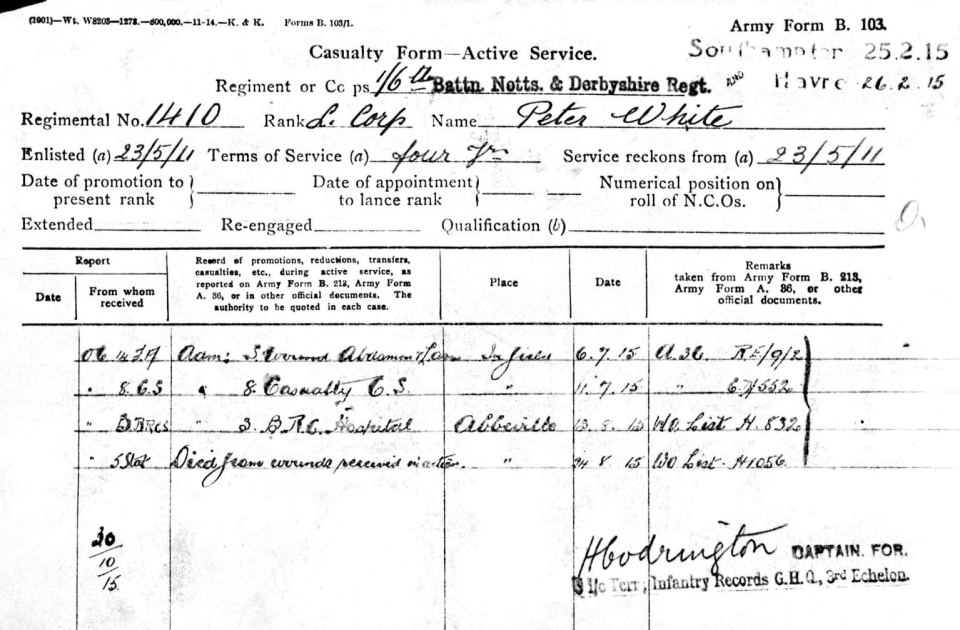 Casualty Form – Active Service Army Form B. 103 for 1410 L/Cpl Peter White (WO363).
Casualty Form – Active Service Army Form B. 103 for 1410 L/Cpl Peter White (WO363).
Various Camp Scenes from 1913
 “Clumber” (H.P. Hansen Series #613)
“Clumber” (H.P. Hansen Series #613)
 The ‘Cookhouse’ during the summer Camp at Clumber Park. This post card was sent by Ben Marriott to his mother in Grantham. In it we learn that the weather is very hot and that the gardener’s lad was selling oat cakes. It seems that likely that Ben was not a member of the 6th Battalion, but purchased the card to send to his mother. In the picture we can see the Sergeant Cook and his men.
The ‘Cookhouse’ during the summer Camp at Clumber Park. This post card was sent by Ben Marriott to his mother in Grantham. In it we learn that the weather is very hot and that the gardener’s lad was selling oat cakes. It seems that likely that Ben was not a member of the 6th Battalion, but purchased the card to send to his mother. In the picture we can see the Sergeant Cook and his men.
 A group of 6th Battalion men in Camp (unknown publisher #14).
A group of 6th Battalion men in Camp (unknown publisher #14).
 This Pioneer is wearing seven efficiency stars, an Imperial Service Badge and what could be the ribbon of a Distinguish Conduct Medal.
This Pioneer is wearing seven efficiency stars, an Imperial Service Badge and what could be the ribbon of a Distinguish Conduct Medal.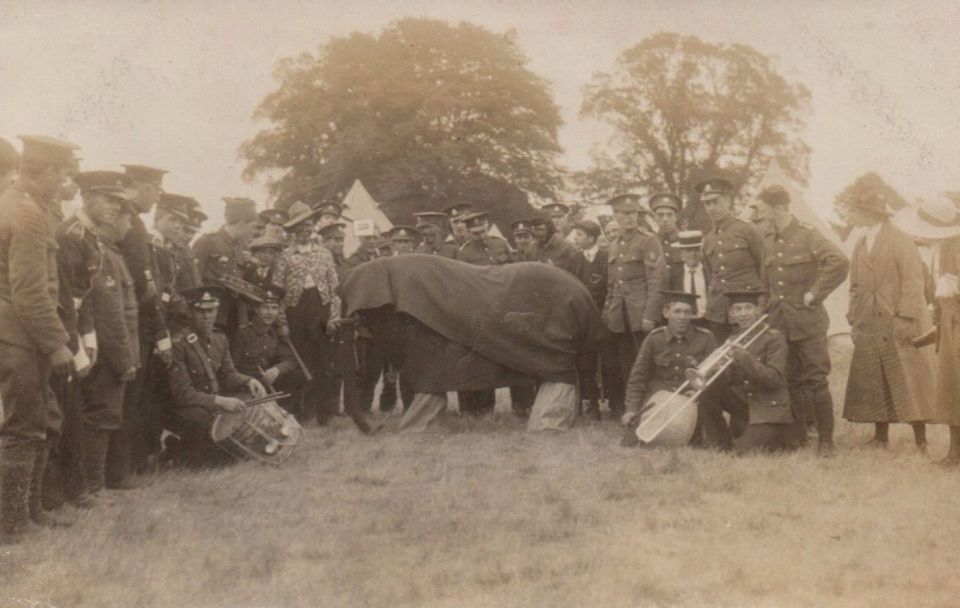
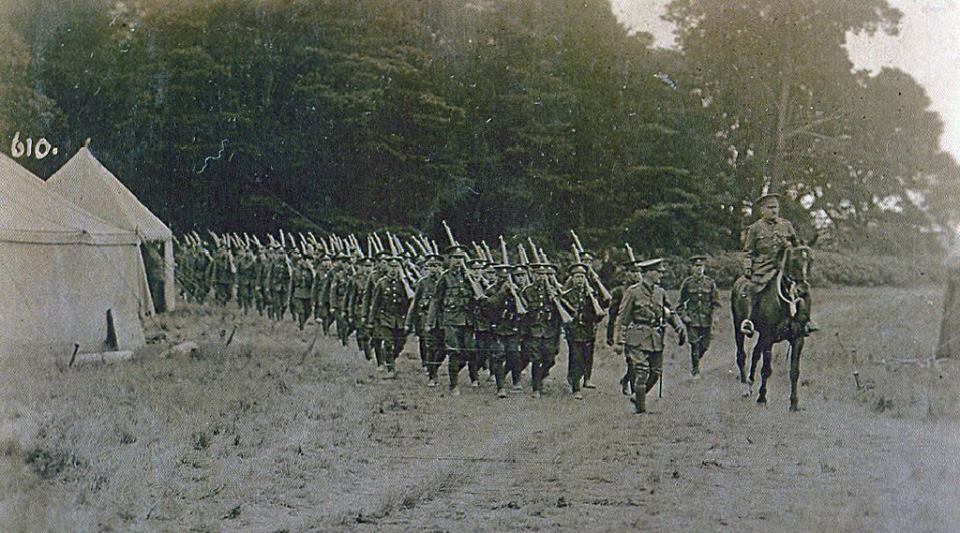 “A” (Chesterfield) Company of the 6th Battalion Sherwood Foresters marching to parade in Clumber Park (unkown publisher #607 & #610).
“A” (Chesterfield) Company of the 6th Battalion Sherwood Foresters marching to parade in Clumber Park (unkown publisher #607 & #610).
These are most likely two pictures of “A” (Chesterfield) Company marching to join a Battalion parade and were clearly taken very close to each other. Colonel Clayton is mounted on his horse, whilst the Officer by his side is Captain Hopkins, Officer Commanding “A” Company.
 The award of a Territorial Force Efficiency Medal. A Brigade Staff Officer is seen presenting a Territorial Force Efficiency Medal to one of the men of the Battalion. Also present in the party is Colonel Clayton and Lieutenant Broomhead. To the left of the Column is the Band and Duke II, the Battalion Mascot. During 1913 the following NCOs and men received the Territorial Force Efficiency Medal:- “C” Company, Corpls 172 James Mellor and 265 John Mycock, Lc-Corpl. Henry Parker and 715 Sergt. A Renshaw; “D” Company, 479 Sergt. Henry D Rye; “E” Company 272 Clr.-Sergt. Lewis G. Dickenson and 14 Pte J Yates; “G” Company, 137 Q.M. Sergt. Joseph Farnsworth.
The award of a Territorial Force Efficiency Medal. A Brigade Staff Officer is seen presenting a Territorial Force Efficiency Medal to one of the men of the Battalion. Also present in the party is Colonel Clayton and Lieutenant Broomhead. To the left of the Column is the Band and Duke II, the Battalion Mascot. During 1913 the following NCOs and men received the Territorial Force Efficiency Medal:- “C” Company, Corpls 172 James Mellor and 265 John Mycock, Lc-Corpl. Henry Parker and 715 Sergt. A Renshaw; “D” Company, 479 Sergt. Henry D Rye; “E” Company 272 Clr.-Sergt. Lewis G. Dickenson and 14 Pte J Yates; “G” Company, 137 Q.M. Sergt. Joseph Farnsworth.
 The Medical Officer and Orderly. Surgeon Captain Arthur Wilson Shea with his medical orderly and pet dog outside the Battalion medical station.
The Medical Officer and Orderly. Surgeon Captain Arthur Wilson Shea with his medical orderly and pet dog outside the Battalion medical station.
 Arthur Wilson Shea was born in Dublin in 1866, but he later moved to Chesterfield when a Medical Student and lived with his adopted brother John, also a Physician, in Eastwood House. Arthur read for the degree of Licentiate of the Society of Apothecaries at the University of London and by 1901, aged 35, Arthur Shea L.S.A. Lond. was practicing in Chesterfield as a Surgeon. In 1911 John Goodwin Shea was Medical officer for the children’s homes of Chesterfield. Arthur Shea, gentleman (late Captain) was Commissioned Surgeon Lieutenant in the 2VB, the Sherwood Foresters in November 1906. He was promoted to Surgeon Captain in April 1908 and to Surgeon Major on 5th August 1914. He proceeded to France with the Battalion in February 1915. He was later awarded the D.S.O in 1918 for conspicuous gallantry and devotion to duty and the Territorial Decoration in May 1919.
Arthur Wilson Shea was born in Dublin in 1866, but he later moved to Chesterfield when a Medical Student and lived with his adopted brother John, also a Physician, in Eastwood House. Arthur read for the degree of Licentiate of the Society of Apothecaries at the University of London and by 1901, aged 35, Arthur Shea L.S.A. Lond. was practicing in Chesterfield as a Surgeon. In 1911 John Goodwin Shea was Medical officer for the children’s homes of Chesterfield. Arthur Shea, gentleman (late Captain) was Commissioned Surgeon Lieutenant in the 2VB, the Sherwood Foresters in November 1906. He was promoted to Surgeon Captain in April 1908 and to Surgeon Major on 5th August 1914. He proceeded to France with the Battalion in February 1915. He was later awarded the D.S.O in 1918 for conspicuous gallantry and devotion to duty and the Territorial Decoration in May 1919.
The 5th (Derby) Battalion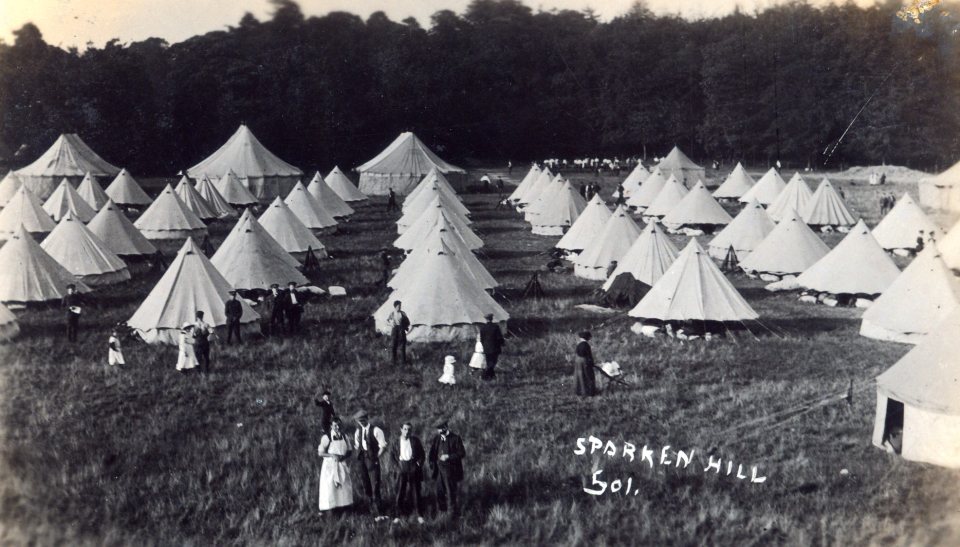
H.P. Hansen Series #501.
The 7th (Nottingham) Battalion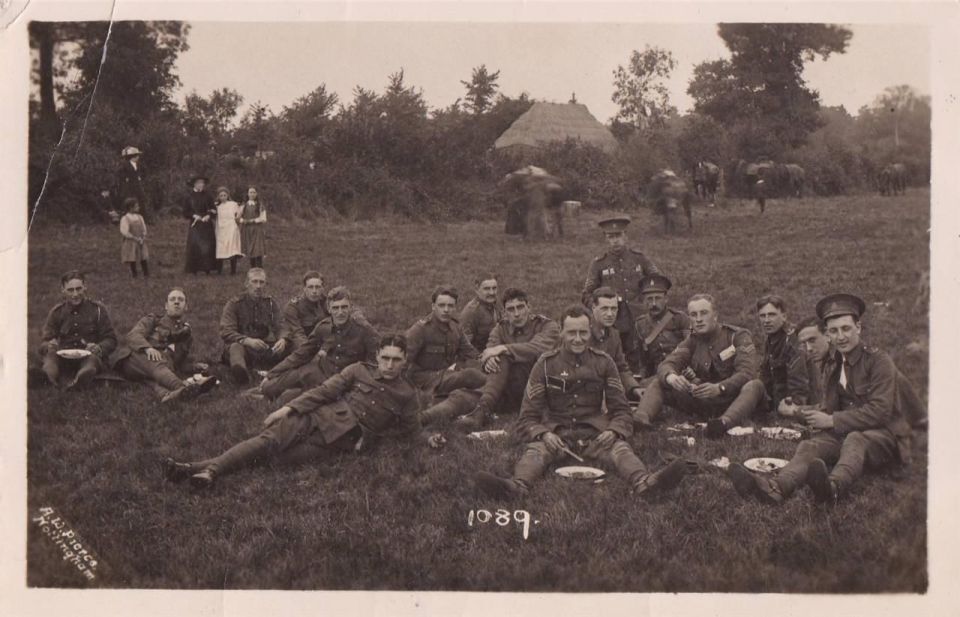
The 8th (Nottinghamshire) Battalion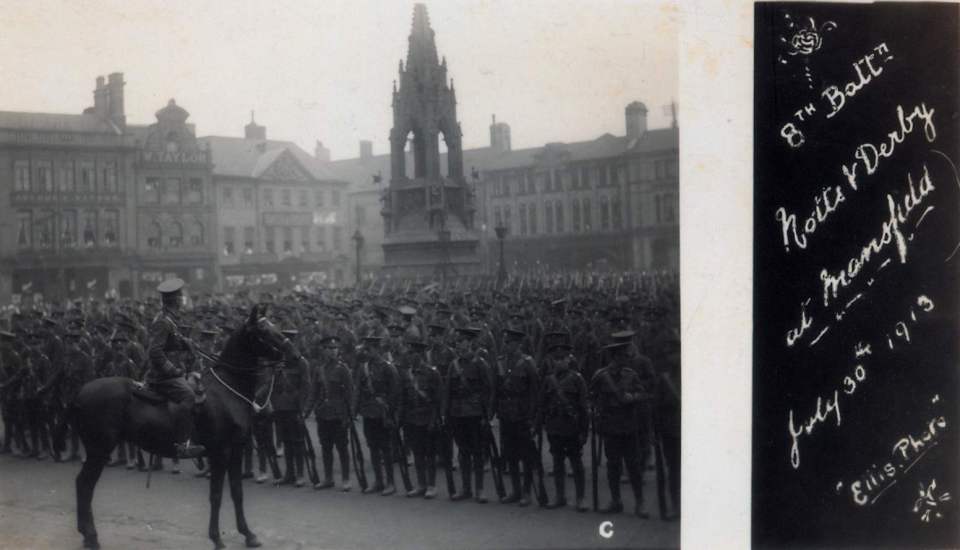
“On Wednesday, the 30th July, the Battalion paraded at 6.30 a.m., and marched vis Church Warsop and Mansfield Woodhouse to Mansfield, with some slight opposition from a skeleton rearguard en route. On arrival at Mansfield they were met in the Market Place by the Major, Mr. J. P. Houfton, and the Corporation, who welcomed them. . . .” “8th Notts. T.F. Thoresby Camp 1913”
“8th Notts. T.F. Thoresby Camp 1913”
The 2nd Battalion Recruiting March
“….and on October 2nd all Chesterfield was astir to welcome the 2nd Battalion on tis march to Sheffield.”
Men of the 2nd Battalion taking a road side rest whilst on manoeuvres. On the 2nd October 1913, the 2nd Battalion Sherwood Foresters passed though Chesterfield and the territorial district of the Regiment on its recruiting march to Sheffield.
 “On Manoeuvres 1913” (unknown publisher #M16)
“On Manoeuvres 1913” (unknown publisher #M16)
Headquarters staff, the battalion band and “E” and “G” Companies of the 2nd Battalion were met by the band of the 6th Battalion at the boundary of Chesterfield and together they marched to the Market Place through throngs of local people. At the Market Place were assembled the Old Comrades of the Regiment and the National Reserve. The Mayor of Chesterfield, Major Robinson, in welcoming the Battalion on behalf of Chesterfield said that the last time he had seen any of the Regular battalions was in South Africa during the War. The Officers of the Battalion were entertained to Dinner by Mr C. P. Markham, and the N.C.O.’s and men by Major Robinson. Both Markham and Robinson were old Officers of the 6th Battn and the guests included His grace the Duke of Devonshire.


 The 2nd Battalion band at an unknown location in Derbyshire (unknown publisher).
The 2nd Battalion band at an unknown location in Derbyshire (unknown publisher).
 Group of 2nd Battalion N.C.O.s and men at an unknown location in Derbyshire (unknown publisher).
Group of 2nd Battalion N.C.O.s and men at an unknown location in Derbyshire (unknown publisher).
 In all three pictures the men are wearing the Regular Army 3-tier “Notts and Derby” should badges and the man in the bottom photograph is holding a .303 Short Magazine Lee-Enfield (S.M.L.E.) which was not issued to the Territorial Battalions until late 1916. The topography of the land also suggests that the picture was taken in the Derbyshire dales.
In all three pictures the men are wearing the Regular Army 3-tier “Notts and Derby” should badges and the man in the bottom photograph is holding a .303 Short Magazine Lee-Enfield (S.M.L.E.) which was not issued to the Territorial Battalions until late 1916. The topography of the land also suggests that the picture was taken in the Derbyshire dales.
Other Notable Events
The strength of the Battalion on December 1st was 26 Officers and 952 Other Ranks.
- TF Reserve – 4 Officers and 37 Other Ranks.
- Attached from National Reserve – 1 Officer and 100 Other Ranks.
Officers :-
- Lieutenant HC Brook-Taylor was promoted to Captain and took over Command of Left “D” Company (vice Captain Blackwall who transferred to “E” Company.
- Captain CEV Langford transferred to the Reserve.
- Lieutenant Arthur Cuthbert Brook-Taylor transfered to the 6th Battalion Manchester Regiment.
- Lieutenant Tomkins to Reserve.
- Lieutenant Humble Resigned.
- 2/Lt HH Jackson Gazetted.
- 2/Lt Idwal Davies Gazetted.
- 2/Lt ES Woods transferred from Officers Training Corps.
Permanent Staff :-
- Act.-Sergt.-Major John Shepherd discharged to pension.
- Clr-Sergt G Wain discharged to pension. Most likely to be 3635 G Wain who served with the 2nd Battalion in India (Punjab Frontier 1897-98).
- Sergt H Jackman posted to B Company.
- Clr.-Sergt W Seaton appointed Act Sergt-Major (Awarded LSM in 1912).
- Clr.-Sergt WL Jackson to C Company.
- Sergt Poston posted from 2nd Battn.
- Sergt Pleasant returned to regulars.
6258 George Pleasant, 2nd Derbyshire Regiment number 4 Company, the 28th Mounted Infantry served in South Africa 1901-2 (Cape Colony, Orange Free State & Transvaal).
The Territorial Decoration and Territorial Efficiency Medal:-
- Captain and Hon. Major JK Goodall
- Cpl. J Mellor (C Company)
- Cpl. JW Mycock (C Company)
- L/Cpl. H Parker (C Company)
- Sergt. A Renshaw (C Company)
- Sergt. Henry D Rye (D Company)
- Clr.-Sergt. LewisG Dickenson (E Company)
- Pte. J Yates (E Company)
- QM.-Sergt. Joseph Farnsworth (G Company)



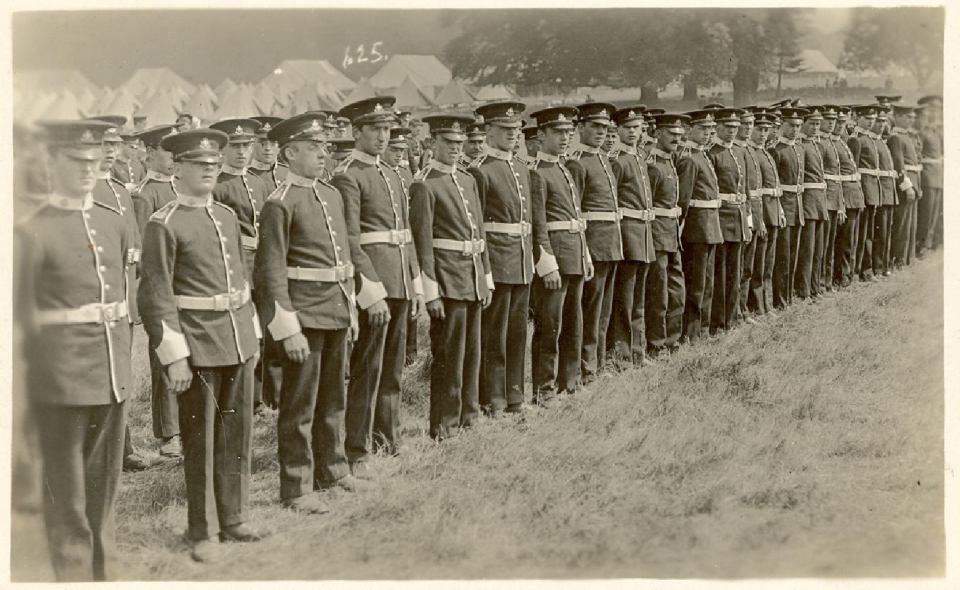


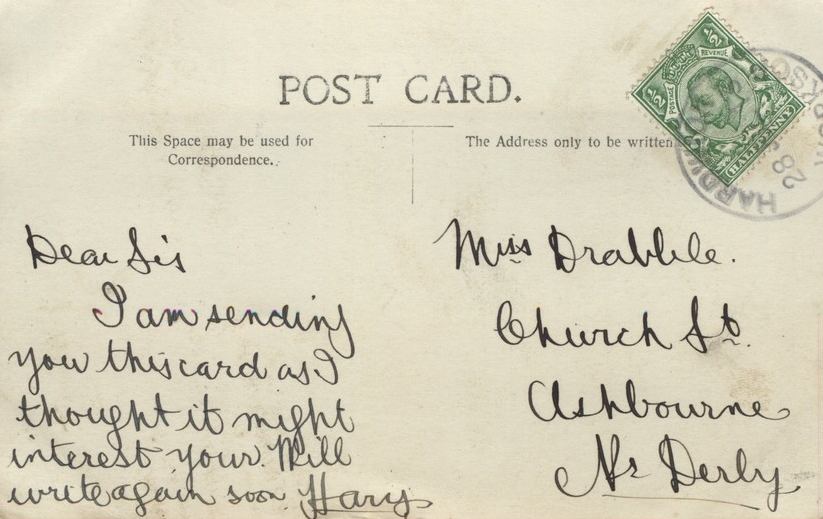





Another thumbs up from me Mike, found two mentions of one of my latest men 172 Cpl/Sgt James Mellor! Great work. Thanks. 😉
Shane
Shane, 172 James Mellor is a bit of a mystery. He was one of the first men to enlist into the 6th Battn and clearly went overseas with the 1/6th Battalion in Feb 1915 (see MIC and Medal Role). But what I can’t understand is why he was given 238002 in the 1917 TF renumbering and not 240019. There does seem to have been some transfers from the 1/6th to the 1/5th ‘in the field’ on the 26th January 1917 and I think that he was part of that, which may explain the number change.
Mike,
Hi I wonder if you can help. I am the Great Nephew of 1853 Private Charles Gordon Shaw A Company 1/6th (Territorial) Battalion Sherwood Foresters . He was wounded on the 1st July 1916 when ‘A’ Company attacked the German lines. The story in the family goes that he was trying to cut through British wire so that his Company could advance, seconds before his Officer had been mortally wounded trying to do the same thing. It appears a Sgt dragged the Officer, Charlie and other men back under fire. It is believed that Charlie was hit in the stomach by the nose of a shrapnel shell, he was quickly bought back to England but died of his wounds a few days later. There appears to be some confusion though over what his wounds were. Last Saturday was a momentous day as my wife and I and my Auntie (Charlie’s niece) visited the Christ’s Church Chapel at Stone Gravels Chesterfield where the Church Warden told us that he had located the exact spot of Charlies’s unmarked grave in the cemetery after years of searching. There is a headstone near the entrance of the cemetery placed there by the CW&WGC in around 1926 that states “Buried Elsewhere in this Church Yard” Charles Gordon Shaw. The Warden is now arranging with the CW&WGC to have a new stone placed on the plot of Charlie’s grave as near to the 100th anniversary of his death as possible. I have found a very poor head and shoulders Army photo of Charlie on his epitaph on your site page Chesterfield Sherwood Foresters on the Somme. Do you have any other pictures of Charlie in your archive or the original of the one on your webpage. We would be very grateful if you could tell us anything more about Charlie and confirm what actually happened to him. Thank you in advance.
Ian Shaw
Lincoln
Ian.shaw1@btinternet.com
Ian
Fantastic that you’ve got in touch! I came across the story of Charles, Sergt Wagg, Lieut Wheatcroft etc quite by accident when I was researching my own family history. The story was reported in the Derbyshire Times and as I read it – it got my hooked on WW1 ever since! It’s quite a little cameo of what happened on the 1st July and many years ago I also had email contact with the relatives of Sergeant Wagg, who of course won the DCM for dragging the wounded men to safety. 1) I had no idea his grave had been ‘lost’ 2) I will send a copy of the story in the paper 3) the only photo I have is from a microfiche of the paper and not much better than on the web. I’ll get it all together and email it to you. (p.s. If the CWGC replace the stone and have a small service please let me know)
cheersMike
Quite interesting Mike, thanks for the additional info. Unfortunately there are no papers for him. I’m hoping he may be a Chesterfield man but can’t be 100% based on ancestry searches. Still its a combination I like and do have a little more info other than his MIC/medal role. Thanks again, Shane
Mike,
As requested here are the details of a Commemoration Service for Charlie that is being held in Chesterfield.
On the 11th July 2016 at 1400 Hours in the Christ Church, Stonegravels Church and Church Yard in Chesterfield, we will be holding a service to commemorate my Great Uncle: and the many other brave men and officers of the 1/6th (Chesterfield) Battalion of the Notts & Derby, Sherwood Foresters Regiment. As this July is the 100th anniversary of the Battle of the Somme and will be exactly 100 years to the day on the 11th when Charlie was buried. The service is being arranged by the Church Warden Mr John Holmes and will be attended by the Mayor of Chesterfield, The Royal British Legion Standard Bearers and Bugler, Shaw family members and family members of Sgt Dick Wagg who was awarded the Distinguished Conduct Medal for rescuing Lt. Wheatcroft the Platoon Officer, Charlie and another Private whilst under heavy enemy fire on that dreadful morning. The Service will be officiated by the Honorary Padre of the Sherwood Foresters Regiment. After the service I will give a brief talk in the church explaining about Charlie’s and the 1/6th Battalion’s part in the Battle of Gommecourt Wood on the first day of the Battle of the Somme, any input from yourself would be highly valued.
Best Regards
Ian Shaw
p.s I have emailed you with more info attached.